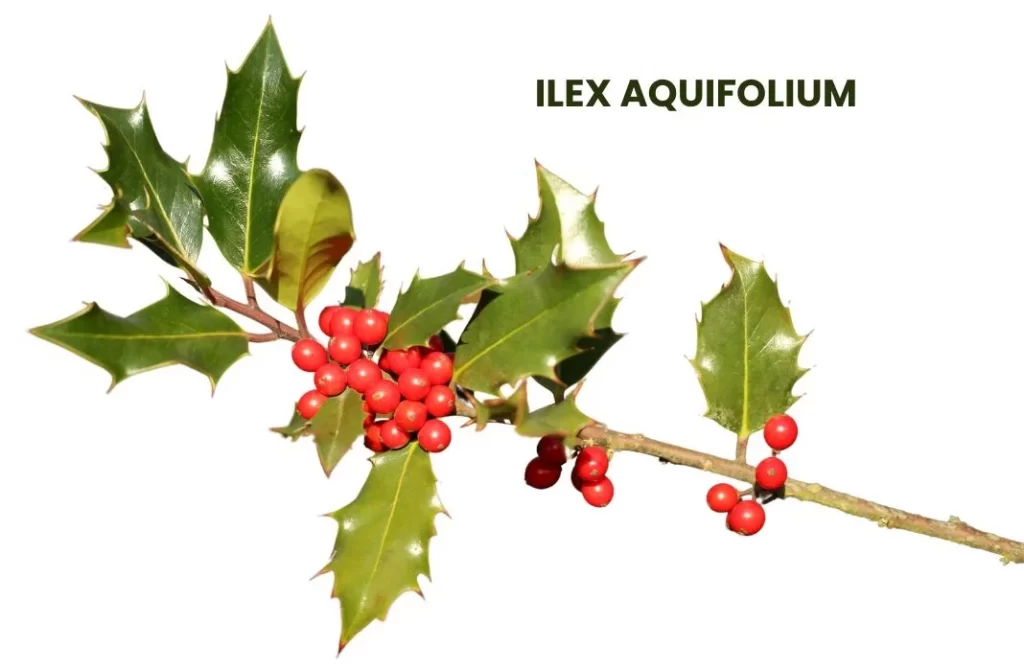Ilex aquifolium, commonly known as American Holly, is a tree native to the eastern and southeastern regions of North America.
It is noted for its distinctive glossy, spiny leaves, and bright red berries.
In homeopathy, Ilex aquifolium is used primarily for intermittent fevers and certain eye and spleen-related symptoms, with an interesting characteristic of symptoms ameliorated in winter.

DETAILED SOURCE INFORMATION
Scientific Classification
- Kingdom: Plantae
- Clade: Tracheophytes
- Class: Magnoliopsida
- Order: Aquifoliales
- Family: Aquifoliaceae
- Genus: Ilex
- Species: Ilex aquifolium
Origin and Distribution
- Ilex aquifolium, commonly known as American Holly, is native to the eastern and southeastern regions of North America, including parts of the United States and Canada.
- It typically grows in forests and woodlands, preferring moist and well-drained soil conditions.
- It is characterized by its glossy, spiny leaves and bright red berries, which make it a popular ornamental plant in gardens and landscapes.
Historical and Medicinal Use
- American Holly has a history of use by Native American tribes for various medicinal purposes, though specific historical records of its use in traditional medicine are limited.
- The berries were traditionally used for their astringent properties, and the plant has been incorporated into modern herbal and homeopathic practices for its therapeutic effects.
Homeopathic Use and Pathogenesis
- In homeopathy, Ilex aquifolium is primarily indicated for conditions such as intermittent fevers, eye symptoms including corneal infiltration and staphyloma, and spleen pain.
- It is notable that symptoms are often aggravated in warmer temperatures and improve during winter, suggesting a specific affinity for cold conditions.
- Homeopathic practitioners prescribe it in low potencies, following individualized treatment principles.
DRUG PATHOGENESIS
Ilex aquifolium affects the body by addressing symptoms related to intermittent fevers, eye issues such as corneal infiltration and staphyloma, and spleen pain.
It is notable that symptoms improve during winter months, suggesting a specific affinity for cold conditions.
KEY CHARACTERISTICS
EYE SYMPTOMS
- Corneal Infiltration: Cloudiness or opacity of the cornea due to the accumulation of fluid or cells, causing impaired vision.
- Staphyloma: Bulging or protrusion of the eyeball, often due to weakening of the outer layers of the eye.
- Nocturnal Burning Sensation in the Eye Orbits: A sensation of burning or discomfort around the eyes specifically felt during nighttime.
- Rheumatic Inflammation of the Eyes: Inflammation of the eyes characterized by pain, redness, and possibly swelling, often worsened by cold and damp conditions.
- Psilosis: Dryness and scaling of the eyelids, leading to flakiness and discomfort.
GENERAL SYMPTOMS
- Intermittent Fevers: Episodes of fever that occur at irregular intervals, often accompanied by chills and sweating.
- Spleen Pain: Pain or discomfort in the area of the spleen, which is located in the upper left part of the abdomen.
- Symptoms Ameliorated in Winter: Relief or improvement of symptoms during the winter season, suggesting sensitivity or aggravation to warmth or heat.
MODALITIES
Symptoms are notably better in winter, suggesting aggravation in warmer temperatures.
RELATIONSHIP WITH OTHER DRUGS
ILEX PARAGUAYENSIS (YERBA MATE)
- Symptoms and Uses: Yerba Mate is known for causing persistent epigastric pain, dryness of the mouth and pharynx, anorexia (loss of appetite), pyrosis (heartburn), nervous depression, and neurasthenia (general fatigue and weakness).
- It also induces somnolence (drowsiness), incapacity for work, decreased urinary secretion, headache, and pruritus (itching).
- It is indicated for hemicrania (migraine) and renal colic (kidney stone pain).
- Yerba Mate is considered a prophylactic against sunstroke and acts as a safe stimulant to circulation, diaphoresis (sweating), and diuresis (increased urine production).
ILEX VOMITORIA (YAUPON)
- Properties: Yaupon has emetic properties, meaning it induces vomiting.
- Despite this, it possesses tonic (invigorating) and digestive qualities without causing sleeplessness.
- Yaupon contains an active principle known to act as a potent diuretic, making it beneficial in conditions like nephritis (kidney inflammation) and gout (a type of arthritis caused by uric acid buildup).
ILEX CASSINE (CHRISTMAS BERRY TEA)
- Properties: Christmas Berry Tea, derived from Ilex Cassine, is renowned for its diuretic properties, making it effective as a substitute for regular tea.
- It promotes increased urine production and is beneficial in conditions requiring diuresis.
Summary
Ilex aquifolium (American Holly) shares botanical relationships with these plants due to their common genus, Ilex. Each species exhibits unique therapeutic properties:
- Yerba Mate for digestive ailments, nervous disorders, and as a stimulant.
- Yaupon for its emetic, tonic, and diuretic properties without causing insomnia.
- Christmas Berry Tea as a diuretic substitute for tea.
DOSE
- Typically administered in low potencies in homeopathic practice.
Frequently Asked Questions
What are the main symptoms that Ilex aquifolium treats?
- It is primarily used for intermittent fevers, eye symptoms like corneal infiltration and staphyloma, and spleen pain. Symptoms improve in winter.
How should Ilex aquifolium be dosed?
- It is usually given in low potencies in homeopathy, following the principles of individualized treatment.
Meaning of Difficult Words
- Corneal infiltration: Condition where the cornea becomes cloudy due to the accumulation of fluid or cells.
- Staphyloma: A bulging of the eyeball.
- Psilosis: Dryness and scaling of the eyelids.
- Epigastric: Upper central region of the abdomen.
- Nephritis: Inflammation of the kidneys.
- Diuresis: Increased production of urine.
- Astringent: Substance that contracts tissues, reducing secretions or discharges.
This comprehensive overview provides insights into the usage, characteristics, and application of Ilex aquifolium in homeopathic practice.
